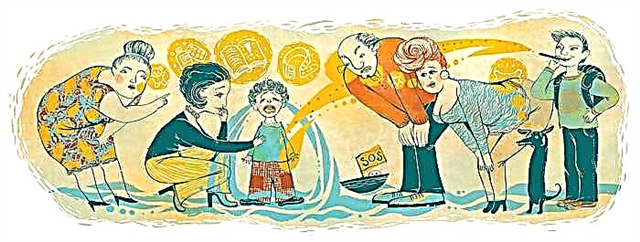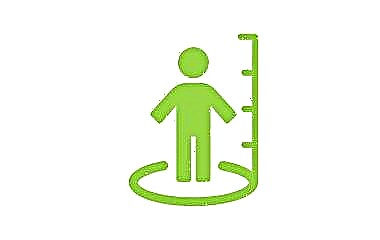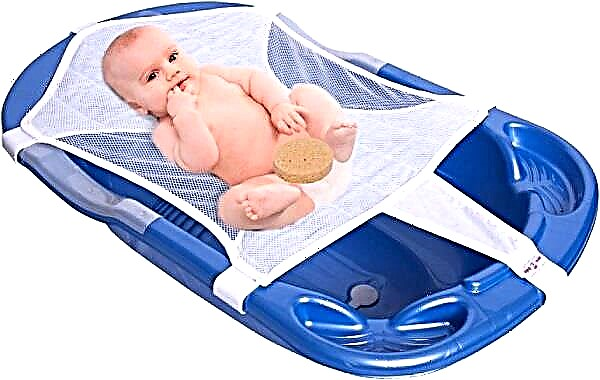You have passed the newborn stage. Already in the second month of a child's life, you begin to understand his personality. You have also already learned to understand the signs that a two-month-old baby gives, his likes and dislikes.
You have passed the newborn stage. You have also already learned to understand the signs that a two-month-old baby gives, his likes and dislikes.
You know the reasons for dissatisfaction, which at the moment are rather primitive: hunger, sleepiness and dirty diapers.
Vision
Babies are born very short-sighted, which means they see better at close distances.
 A child of the second month of life learns to follow a moving object with his gaze, is more interested in shapes and patterns, and can also notice familiar faces even from a distance. The human face is one of the favorite objects of an infant to look at, especially if it is his own face or that of a parent.
A child of the second month of life learns to follow a moving object with his gaze, is more interested in shapes and patterns, and can also notice familiar faces even from a distance. The human face is one of the favorite objects of an infant to look at, especially if it is his own face or that of a parent.
Place a baby-safe baby mirror at toddler's eye level and watch your baby watch himself.
Your baby's color vision continues to develop at two months of age, so bright wall decorations or toys will help develop your baby's ability to distinguish colors. Soft pastel colors are difficult for a child to appreciate and should be borne in mind when shopping for toys and books.
In children at 2 or 2.5 months, eye coordination improves to follow a moving object.
Hearing
A baby 2 months old begins to identify the voices that he heard more often.
Regular speaking (or singing) is a great way to help your baby get used to their voice, and is also one of the ways to calm your baby.
The infant will enjoy listening to music (include different styles) and may be enchanted by the normal sounds of the world around him. Keep your baby close as you rattle pots while preparing dinner, and let the older brothers and sisters laugh and play within earshot.
Baby rattles and music mobiles are good methods to stimulate your baby's hearing.
Motor skills
 The motor development of the child in the second month is characterized by greater control over the position of the body. This means that the baby in a prone position or upright can hold his head more stable than before.
The motor development of the child in the second month is characterized by greater control over the position of the body. This means that the baby in a prone position or upright can hold his head more stable than before.
Babies maintain a strong sucking reflex at two months of age. You may notice that the baby likes to suck on his fist or fingers. This is one of the best methods of comforting children.
At 2 months old, the infant does not yet have sufficient coordination for playing with toys. But he can hit the colorful object hanging in front of him. At 2 months, the baby may begin to reach for objects. This is the beginning of the manifestation of hand-eye coordination.
At 2 months, the baby can even hold a little toy that you put in one of his hands.
Communicative development of a child at 2 months of life
For a two month old baby, crying is the primary means of communication. But sometimes you can hear gurgling, grunting and humming. The child must identify the face and voice of the parents. Perhaps you will find the first delightful hint of a smile.
One of the most important things a parent can do at this age is to talk to a child. Despite the fact that children of two months of age cannot speak, they react to the sound of the parent's voice, and this prompts them to begin to form their first words.
Behavior
Many babies peak in crying episodes at 2 months, leaving parents almost as upset. There are many reasons why a child cries even when it seems like all his needs have been met. The maturation of the nervous system, overwork, or simply the need to calm down are some of the most common reasons.
There will be times in these early months when parents just need to keep an eye on their baby's needs and follow their instincts.
What should a child be able to do?
- the child holds his head more steadily;
- many of the neonatal reflexes still persist. For example, the sucking reflex;
- the child is trying to hook with the handles objects that you place in front of them;
- vision develops and the baby can see objects up to 45 cm away;
- the baby begins to follow what is happening with his eyes;
- the baby loves to listen to the voice and singing;
- the scream may contain more grunts;
- the baby begins to turn his head to the sounds;
- some parents are lucky to see the first conscious smile of a baby.
Care
Caring for a baby at 2 months is not much different from the newborn period. The difference lies in the number of feedings, sleep time, educational games and toys.
Feeding
This month, your baby will demand to be fed more often. Try to follow and trust the signs your baby gives when it comes to feeding times.
 When breastfeeding, both breasts should be offered to promote better lactation.
When breastfeeding, both breasts should be offered to promote better lactation.
If you feed with a formula, at this age the number of feedings decreases with an increase in the one-time volume of the formula. This will happen as the baby matures. Because babies do not digest formula as quickly as breast milk, parents generally do not need to feed a formula-fed baby as often as a breastfed baby.
Two month old babies usually drink 6 - 8 bottles of 120 - 180 ml per day, and an additional 30 ml of formula may be needed when the infant is 3 months old.
At two months old, babies will still need 1 to 2 feeds per night, but they may have a longer sleep period, such as 5 to 6 hours between a pair of night feeds.
This longer, uninterrupted sleep can be an ideal opportunity for parents to compensate for the lack of sleep in the previous weeks, so take advantage of it.
Sleep
The baby's sleep pattern is stabilizing, but at two months it is not yet fully established. At this age, babies sleep 15 to 16 hours a day. But these hours are random and children are usually not ready to sleep through the night. This is especially true for infants who wake up to eat about every three hours.
 Hang on for a few more weeks and you should be able to get some much needed rest.
Hang on for a few more weeks and you should be able to get some much needed rest.
You need to help your baby learn to fall asleep on his own. Place your baby in the crib when he is drowsy rather than sound asleep. He can sleep in the same room as you, but sleeping in your bed is not recommended.
All babies should be laid on their back to reduce the risk of sudden infant death syndrome. Allow your child to spend a lot of time lying on his stomach when he is awake and supervised by an adult.
Also, remove all soft items from the crib, including pillows, blankets, stuffed animals, and partitions.
Don't let your child overheat. Maintain an adult-friendly room temperature. Never dress your baby in more than one layer. Do not cover your baby's face or head while he sleeps.
Do not raise the headboard in the child's bed. The child may roll into a position that makes breathing difficult.
Vaccination
At 2 months, the baby should be given the first vaccinations. Mark the date in your calendar or diary when your baby is 2 months old so you don't miss vaccinations.
Security measures
Give your baby enough time every day. Pets should be kept away from the infant. Never leave your baby unattended on the changing table, on the floor, or in an unsafe place. Toys should be round and soft, with no sharp edges.
How to develop a baby at 2 months?
Whenever you and your baby are awake, take the opportunity to play. Through play, you will help your child develop both mentally and physically.
You can use the following developmental activities with your baby at 2 months old.
Lying on your tummy
This is an important sensory activity in an infant's daily life. The prone position helps develop coordination and strengthens the child's neck, shoulders, arms and spine.

This position helps with motor skills such as rolling, crawling, stretching, and sitting.
Reading
It's never too early to start reading to your child. Since children love hearing their parents' voices, ensure that both parents take turns reading. Reading has many benefits, so it's good to get used to it every day.
Benefits:
- the ability to listen develops;
- promotes language development;
- helps in the development of attention and memory;
- strengthens the bond between you and your baby.
Tips for parents:
- read to your baby in a quiet place;
- you don't have to read every word in a book;
- you can describe what you see on each page;
- have fun reading. Use facial expressions, lively voices and just plain stupidity.
The magic of the human touch
It is an easy sensory activity that has amazing benefits for you and your young child.
What can be done:
- skin-to-skin contact;
- hugging the child often;
- swinging the child;
- baby massage.
Some of the benefits:
- creating a bond between you and the baby;
- strengthening of psychological and physical health;
- improved sleep;
- massage helps babies cope with stress;
- massage stabilizes autonomic functions such as heart rate and temperature;
- massage will help relieve pain.
Movement with a child
Movement with the child helps in the development of the vestibular system.
How can you move? You can turn on your favorite music and dance with your child. You can swing it down, side to side, or lift it up. You can move your child quickly and slowly. Remember to stop about every minute. This will allow the body to lock in movement and make sure the baby is not overly aroused.
Explore by touch
The development of tactile sensations is important. Through touch, the child learns about his body and environment. Remember, this isn't just about using your hands. It includes the whole body.
So whenever the temperature allows you to undress your baby to a diaper, let him explore the variety of textures. It helps in the development of many skills, including large and small motor skills.
Here some ideas:
- Place the baby on a variety of fabrics or blankets. It can be wool, silk, cotton. Always make sure your child is comfortable.
- Place various embossing materials or toys in your baby's hands. Examples may include various fabrics, rattles, rings.
- Moving various embossed materials on the arms, legs, face, stomach and back. Again, these can be different fabrics or toys, such as feather tickling.
- Time to swim! Water covers the entire body, and this is another pleasant sensation. You can use a different textured towels each time to add variety.
Playing with fingers
At this age, the child cannot see far, but there are many things that he likes. The faces are, of course, some of their favorites. Another favorite activity is looking at moving fingers.

What to do? You can let your imagination run wild. The main goal for a toddler is to watch your fingers dance. You can play music and move your hands rhythmically. Up, down, side to side, fast or slow.
You can use finger puppets and have a simple puppet show.
Object observation
At two months, a baby can see up to 45 cm from his face. At this age, the infant can also be fixed on the object and monitor it for a short time. You can promote this skill through the game. You can hold a toy or any object that your baby finds interesting in front of his face. Move it in different directions. In addition, you can hum, talk, or make funny sound effects.
Remember, each baby develops at its own pace. If your child is not ready or interested in these activities, try them again after a few weeks.
Tips on how to care for a 2 month old baby
- The second month of a newborn's life is exciting and unnerving for new parents. Don't be afraid to ask for advice when you need it. A pediatrician is the best source of information, but family and friends are also good counselors and helpers.
- Modern parents are always on the go. As a result, children spend a lot of time in car seats and carriers. Babies should be able to be in different positions throughout the day so that they can use the muscles they need to roll over, crawl, and ultimately walk.
- Touch is very important during the first months of life. Skin contact is beneficial. Some experts recommend baby massage, but just holding or rocking the baby is enough.
- When your child is crying, try different calming techniques. Some children react to soft music or singing. Others are calmed down by "white noise" (for example, starting a vacuum cleaner or installing a radio between stations). If you haven't already, try inserting a pacifier. It is soothing and also helps in preventing sudden infant death syndrome. Experiment to find what works best for your 2 month old.
All children are unique and reach certain levels at their own pace. Development guidelines simply show what the child can fulfill. If not now, then soon. If the baby was born prematurely, it takes a little longer for him to reach his stages of development. If you have any questions about your child's development, see your doctor.



